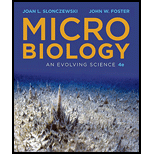
Concept explainers
To review:
The comparison and differences between icosahedral and filamentous symmetry of viruses with examples.
Introduction:
The viral capsid protects and encloses the genetic material of a virus. It is a proteinaceous structure that can be either symmetric or asymmetric. During replication or reproduction of a virus, the genetic material is inserted into the host cytoplasm and the capsid remains outside.
Explanation of Solution
The symmetrical capsid of virus can be of two types: icosahedral and filamentous. This symmetrical geometry proves to be advantageous in packaging the repeating protein units that are produced from the genetic material of the virus. The differences between these shapes of viral capsid are given below:
1. The icosahedral capsid contains 20 triangular faces and each face is formed by three identical proteins that are asymmetrical. The filamentous capsid is composed of monomers that spiral around the genome of the virus.
2. The size of an icosahedral capsid is fixed, however, the length of a helical (filamentous) capsid can be increased to include larger sized
3. The filamentous viruses contain tail fibers at their end that mediate attachment to host cell surface. The icosahedral virus contains glycoprotein spikes in their membrane envelope to aid in attachment.
4. The example of viruses having icosahedral capsid are human immunodeficiency virus (HIV) and herpes simplex virus. The examples of filamentous virus are Ebola virus, influenza virus, and tobacco mosaic virus.
Want to see more full solutions like this?
Chapter 6 Solutions
Microbiology: An Evolving Science (Fourth Edition)
- Noggin mutation: The mouse, one of the phenotypic consequences of Noggin mutationis mispatterning of the spinal cord, in the posterior region of the mouse embryo, suchthat in the hindlimb region the more ventral fates are lost, and the dorsal Pax3 domain isexpanded. (this experiment is not in the lectures).a. Hypothesis for why: What would be your hypothesis for why the ventral fatesare lost and dorsal fates expanded? Include in your answer the words notochord,BMP, SHH and either (or both of) surface ectoderm or lateral plate mesodermarrow_forwardNot part of a graded assignment, from a past midtermarrow_forwardNot part of a graded assignment, from a past midtermarrow_forward
- please helparrow_forwardWhat does the heavy dark line along collecting duct tell us about water reabsorption in this individual at this time? What does the heavy dark line along collecting duct tell us about ADH secretion in this individual at this time?arrow_forwardBiology grade 10 study guidearrow_forward
 Biology (MindTap Course List)BiologyISBN:9781337392938Author:Eldra Solomon, Charles Martin, Diana W. Martin, Linda R. BergPublisher:Cengage Learning
Biology (MindTap Course List)BiologyISBN:9781337392938Author:Eldra Solomon, Charles Martin, Diana W. Martin, Linda R. BergPublisher:Cengage Learning Concepts of BiologyBiologyISBN:9781938168116Author:Samantha Fowler, Rebecca Roush, James WisePublisher:OpenStax College
Concepts of BiologyBiologyISBN:9781938168116Author:Samantha Fowler, Rebecca Roush, James WisePublisher:OpenStax College Biology Today and Tomorrow without Physiology (Mi...BiologyISBN:9781305117396Author:Cecie Starr, Christine Evers, Lisa StarrPublisher:Cengage Learning
Biology Today and Tomorrow without Physiology (Mi...BiologyISBN:9781305117396Author:Cecie Starr, Christine Evers, Lisa StarrPublisher:Cengage Learning Medical Terminology for Health Professions, Spira...Health & NutritionISBN:9781305634350Author:Ann Ehrlich, Carol L. Schroeder, Laura Ehrlich, Katrina A. SchroederPublisher:Cengage Learning
Medical Terminology for Health Professions, Spira...Health & NutritionISBN:9781305634350Author:Ann Ehrlich, Carol L. Schroeder, Laura Ehrlich, Katrina A. SchroederPublisher:Cengage Learning Biology 2eBiologyISBN:9781947172517Author:Matthew Douglas, Jung Choi, Mary Ann ClarkPublisher:OpenStax
Biology 2eBiologyISBN:9781947172517Author:Matthew Douglas, Jung Choi, Mary Ann ClarkPublisher:OpenStax





